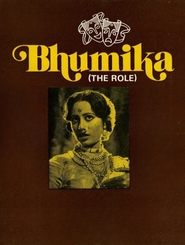The face of a man may change, but not the man himself.
This is a film that is seemingly obsessed with cinematic performance, and the slippage between the world of film and reality, not too distant from Baudrillard's concept of 'simulacra'. Indeed, for those not familiar with Hindi, the word 'bhumika' (भूमिका) itself means 'role'.
In the first instance, whilst Usha's cinematic roles demand her to be happy, she is clearly deeply unhappy off-screen. But just as she must pretend to be happy within the films that she stars in, she must also pretend to be happy in her real-world marriage as well. This is not only to please her cold and cruel husband, but to appease the gossiping and unkind celebrity press as well who serve as an obvious surrogate symbol for Bhumika's very own audience and the Indian public in general. Usha's performance at home, this world of make-believe, is, of course, playing a role in itself just as false as the fairy-tales that she stars in.
The second level of role-playing is that the plot of Bhumika is based on the memoirs of a real-life movie star Hansa Wadkar. Thus Smita-Patil-the-actor is performing the role of Usha. Obviously, she isn't actually Usha as Bhumika is a film: it is not reality. This brings us onto a third level of performance in that, as documented on her Wikipedia page, many parts of Bhumika's narrative match up with Smita-Patil-the-woman's own real life.
The final (?) level of performance or simulation is evident in the film's use of black and white sequences. As Anuj Kuma wrote in The Hindu that:
Today people compare the childhood scenes of Usha with Satyajit Ray’s Pather Panchali but the influence was more accidental than deliberate. […] Running short of colour stock because of some foreign exchange issues, he decided to shoot Usha’s present in colour and past in black and white.
Given the audience's expectations about the lack of colour (crudely, that black and white is only for 'older' films, whilst colour is exclusively for 'newer' ones), the film's entirely artificial use of black and white is in some sense a joke at the audience's expense. That is to say, it is saying: this is all a construction, a performance by the cinematographer. It is not reality. And the fact that parts of Bhumika are only in black and white due to some (essentially artistically arbitrary) economic concern, this only underscores that it is just a performance and the story can adapt to the needs — it is not reality.
(Note that the Shemaroo version floating around on YouTube has been censored. Approximately four minutes that comprise the double-suicide pact prior to the final act have been removed.)
Synopsis: The film follows the life of a successful film star, revealing her increasing alienation in a role both glamorized and patronized by society. After being forced into show business by her family, she spends her time between studios and disastrous love affairs, and feels more and more dissatisfied.

